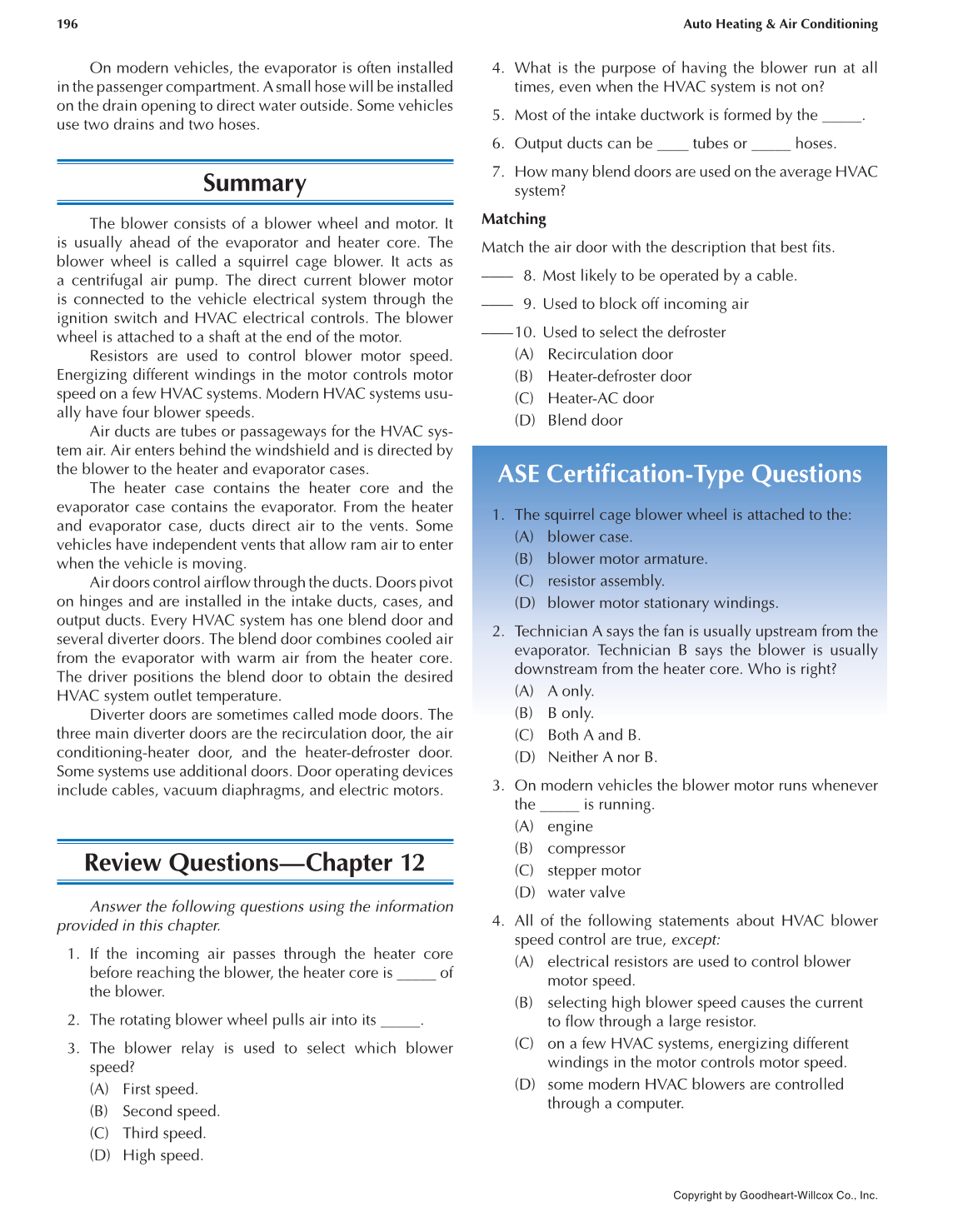196 Auto Heating & Air Conditioning
Copyright by Goodheart-Willcox Co., Inc.
On modern vehicles, the evaporator is often installed
in the passenger compartment. A small hose will be installed
on the drain opening to direct water outside. Some vehicles
use two drains and two hoses.
Summary
The blower consists of a blower wheel and motor. It
is usually ahead of the evaporator and heater core. The
blower wheel is called a squirrel cage blower. It acts as
a centrifugal air pump. The direct current blower motor
is connected to the vehicle electrical system through the
ignition switch and HVAC electrical controls. The blower
wheel is attached to a shaft at the end of the motor.
Resistors are used to control blower motor speed.
Energizing different windings in the motor controls motor
speed on a few HVAC systems. Modern HVAC systems usu-
ally have four blower speeds.
Air ducts are tubes or passageways for the HVAC sys-
tem air. Air enters behind the windshield and is directed by
the blower to the heater and evaporator cases.
The heater case contains the heater core and the
evaporator case contains the evaporator. From the heater
and evaporator case, ducts direct air to the vents. Some
vehicles have independent vents that allow ram air to enter
when the vehicle is moving.
Air doors control airfl ow through the ducts. Doors pivot
on hinges and are installed in the intake ducts, cases, and
output ducts. Every HVAC system has one blend door and
several diverter doors. The blend door combines cooled air
from the evaporator with warm air from the heater core.
The driver positions the blend door to obtain the desired
HVAC system outlet temperature.
Diverter doors are sometimes called mode doors. The
three main diverter doors are the recirculation door, the air
conditioning-heater door, and the heater-defroster door.
Some systems use additional doors. Door operating devices
include cables, vacuum diaphragms, and electric motors.
Review Questions—Chapter 12
Answer the following questions using the information
provided in this chapter.
1. If the incoming air passes through the heater core
before reaching the blower, the heater core is _____ of
the blower.
2. The rotating blower wheel pulls air into its _____.
3. The blower relay is used to select which blower
speed?
(A) First speed.
(B) Second speed.
(C) Third speed.
(D) High speed.
4. What is the purpose of having the blower run at all
times, even when the HVAC system is not on?
5. Most of the intake ductwork is formed by the _____.
6. Output ducts can be ____ tubes or _____ hoses.
7. How many blend doors are used on the average HVAC
system?
Matching
Match the air door with the description that best fi ts.
–––– 8. Most likely to be operated by a cable.
–––– 9. Used to block off incoming air
–––– 10. Used to select the defroster
(A) Recirculation door
(B) Heater-defroster door
(C) Heater-AC door
(D) Blend door
ASE Certifi cation-Type Questions
1. The squirrel cage blower wheel is attached to the:
(A) blower case.
(B) blower motor armature.
(C) resistor assembly.
(D) blower motor stationary windings.
2. Technician A says the fan is usually upstream from the
evaporator. Technician B says the blower is usually
downstream from the heater core. Who is right?
(A) A only.
(B) B only.
(C) Both A and B.
(D) Neither A nor B.
3. On modern vehicles the blower motor runs when ever
the _____ is running.
(A) engine
(B) compressor
(C) stepper motor
(D) water valve
4. All of the following statements about HVAC blower
speed control are true, except:
(A) electrical resistors are used to control blower
motor speed.
(B) selecting high blower speed causes the current
to fl ow through a large resistor.
(C) on a few HVAC systems, energizing different
windings in the motor controls motor speed.
(D) some modern HVAC blowers are controlled
through a computer.
